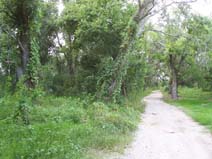Maritime Forests
Jean Landry is the director of The Nature Conservancy (TNC) office located on Grand Isle, LA. Jean runs a one-person operation to ensure that the maritime forest remaining on Grand Isle is preserved, and also leads efforts to restore the forest habitat. Jean relies heavily on support from local government and agencies and volunteers. She also partners with universities in the surrounding area (particularly Nicholls State University and LSU). Between the universities and corporate partners, Jean has an array of volunteers that play a vital role in the success of the maritime restoration on Grand Isle. Jean does not have a college degree in the sciences, but has lived on Grand Isle all of her life. It is her life experiences, connection to Grand Isle, and passion about the success of the project that make her highly qualified to run the Nature Conservancy office.
Maritime Forests on Grand Isle
Today, only 10% of the original maritime forest remains on Grand Isle. The Nature Conservancy is working to both preserve and restore this unique habitat. Grand Isle is an important resting location for
migratory birds along the Mississippi flyway. The maritime forest provides shelter and a resting place for the birds both before and after they attempt the long migration across the Gulf of Mexico. Many migratory bird populations are under stress because of habitat and land loss along their migration routes. The birds are forced to fly longer distances before reaching a resting spot, and many individuals cannot fly the long distances.
Restoration and Preservation Efforts
The Nature Conservancy began the preservation and restoration efforts on Grand Isle in 1998 when the Xavier-Grilletta family from New Orleans donated 13 acres of land to The Nature Conservancy. Before her position with the Conservancy, Jean played a role in connecting land owners who were interested in donating land with TNC. Shortly after the original donation, TNC acquired 4 additional acres called the Jambon tract as well as half of an acre from the Govan family from Alexandria, Virginia. TNC also has 6 acres that are under a management agreement with LSU. The most recent purchase by the TNC was in 2006 when they purchased the 18 acre Landry-Leblanc tract.
In addition to the lands TNC owns, they also have agreements with the Grand Isle Port Commission as well as Exxon Mobile to reforest and preserve a total of about 55 acres.
The forest reforestation process began in 1999 in partnership with Exxon Mobile.They began by reforesting 30 acres of maritime forest. The Nature Conservancy planted Live Oaks, Red Mulberry and Hackberry for 4 consecutive years. Unfortunately, the tree plantings were not as successful as they had hoped, perhaps because the site is subject to high tides that wash saltwater onto the restoration area. In addition, they also had to contend with a spring drought.
 Since the reforestation began,they had been able to successfully restore 220 trees on the site. Jean has had more success with the reforestation on the LSU preserve and the Grilletta preserve because the trees have not had to contend with either fire or saltwater exposure. The tracts are located in a more protected area and the reforestation is more successful.
Since the reforestation began,they had been able to successfully restore 220 trees on the site. Jean has had more success with the reforestation on the LSU preserve and the Grilletta preserve because the trees have not had to contend with either fire or saltwater exposure. The tracts are located in a more protected area and the reforestation is more successful.
An interesting component of the reforestation of Grand Isle is that the specimens planted are grown from seeds collected on Grand Isle. One of the primary goals of the Grand Isle TNC office is to perpetuate the line of trees existing on Grand Isle. TNC does not plant any trees that are not offspring of trees already living on the island.
In addition to the reforestation of the maritime forest, TNC also has a ‘tree giveaway’ program and an education component for children. The tree giveaway program is an effort to plant trees,not only in the preserves owned by TNC, but across the entire barrier island. This is possible by encouraging local residents to plant trees on their property. TNC has had great success with this program, in part because the local residents care for the trees, thereby ensuring their survival.
Partnerships
Jean has also partnered with the Grand Isle School to build a facility during the summer of 2008 in which students will be able to actively participate in gathering seeds from mature trees, planting seeds and, ultimately, participating in the tree giveaway program. Education is a large component of the restoration efforts to ensure that the restoration continues for years to come. Up to this point, the programs have been considered successful in large part due to the support of the programs by the local residents and businesses located on Grand Isle.
Timeline
This restoration project has no timeline and TNC will continue to plant trees and conduct tree giveaways for as long as they have a presence on Grand Isle. Up to this point there has been limited monitoring of the success of the restoration, but that is in part due to the fact that the reforestation program is still very young. The management agreements that TNC has for preservation as well as for reforestation of property have had huge impacts on guaranteeing the expanse of maritime forest. The lands owned by TNC are protected in perpetuity 
Currently, the preserves owned by TNC are open to the public recreation between dawn and dusk,but no camping or hunting is allowed on the preserves.
Further Information:
Video of maritime forest at 3.00 min in http://www.youtube.com/watch?v=gq3o28gnkLE
http://www.nature.org/ourinitiatives/region s/northamerica/unitedstates/louisiana/explo re/the- preservation-of-migratory-bird- habitat-on-grand-isle-louisiana.xml


